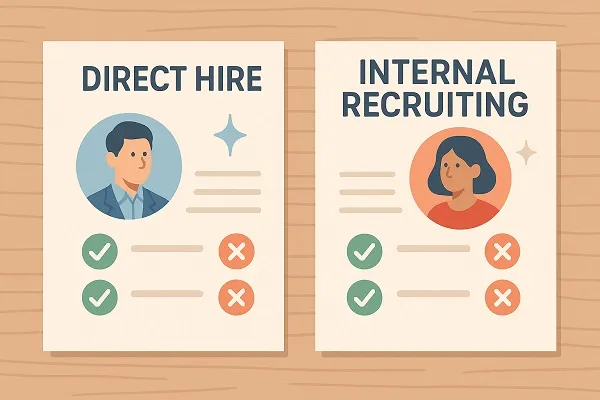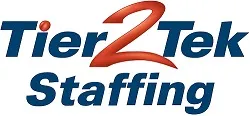When to use direct hire vs internal recruiting is one of the most important considerations for businesses building a strong workforce. Hiring decisions don’t just fill positions—they influence productivity, culture, retention, and the overall direction of your company. Knowing the right circumstances for each approach ensures you’re investing resources wisely and positioning your organization for long-term success.
Why the Hiring Strategy Matters
Every hire shapes the future of your business. Choosing between direct hire and internal recruiting isn’t only about speed or cost—it’s about aligning talent acquisition with broader business objectives. An internal hire can boost employee loyalty, while a direct hire may inject fresh perspectives. The strategy you select impacts performance, team dynamics, and growth potential.
Direct Hire vs Internal Recruiting: Pros and Cons

Understanding the strengths and drawbacks of each approach provides clarity when weighing your options.
Direct Hire Pros:
- Access to specialized skills not available internally
- Brings in new perspectives and external insights
- Strengthens teams during expansion or restructuring
- Can attract experienced leaders to drive change
Direct Hire Cons:
- Higher recruitment and onboarding costs
- Longer adjustment period for culture fit
- Risk of turnover if the new hire doesn’t integrate well
Internal Recruiting Pros:
- Boosts morale and retention by promoting from within
- Faster adaptation since the employee already knows company systems
- Lower upfront hiring costs compared to external searches
- Preserves valuable institutional knowledge
Internal Recruiting Cons:
- May create backfilling challenges for the employee’s old role
- Limits exposure to fresh perspectives
- Risk of favoritism if promotions aren’t managed transparently
Balancing these pros and cons helps leaders choose the most effective method for each hiring scenario.
Situations Where Direct Hire Is the Smarter Choice
While internal recruiting is appealing, some business needs demand external talent. Direct hire is often the right solution in cases such as:
- Specialized Expertise: Positions requiring niche technical skills or certifications.
- Leadership Transitions: New leaders may bring fresh vision and strategies that internal candidates lack.
- Business Expansion: Entering a new market or launching a product line often requires outside knowledge.
- Internal Skill Gaps: If no employee has the necessary qualifications, hiring externally is the only option.
Direct hire ensures your company can innovate, compete, and grow without being limited by current internal capabilities.
Situations Where Internal Recruiting Outperforms Direct Hire
There are also many scenarios where promoting or transferring an internal candidate is the more strategic choice.
- Urgent Needs: Filling roles quickly is easier with someone already in the company.
- Culture-Critical Roles: If cultural alignment is essential, internal recruiting reduces the risk of misfit.
- Retention Strategy: Offering career paths strengthens employee loyalty and reduces turnover.
- Cost-Sensitive Hiring: Internal promotions typically save on recruitment expenses.
In these cases, internal recruiting provides immediate value while reinforcing trust and motivation among employees.
Cost Analysis: Which Option Saves More?

Budget is a significant factor when comparing direct hire vs internal recruiting. Both approaches carry expenses, but in different ways.
Costs of Direct Hire:
- Job postings, recruiter fees, or agency contracts
- Relocation packages for specialized candidates
- Extended onboarding and training investments
Costs of Internal Recruiting:
- Training and upskilling programs for promoted employees
- Adjusted salary or benefits packages
- Cost of filling the employee’s previous position
The short-term financial impact of internal recruiting is usually lower. However, the long-term ROI of direct hire can be higher if the external hire brings new skills that drive growth.
Speed vs. Strategic Value
Timing often dictates the best approach.
- When speed matters most: Internal recruiting allows immediate placement with minimal downtime.
- When long-term strategy is key: Direct hire ensures you’re not just filling a gap but future-proofing your workforce with the right skills and leadership.
Companies should balance urgency with foresight, avoiding the temptation to choose only based on convenience.
Industry-Specific Insights
The choice between direct hire and internal recruiting often depends on industry demands.
- Healthcare: Direct hire is common due to licensing and specialized training requirements.
- Technology: Startups may blend both—hiring externally for engineers while promoting internally for operational roles.
- Retail and Hospitality: Internal recruiting is often favored to retain loyal employees and reduce turnover costs.
- Manufacturing: A hybrid approach works well, combining promotions for operational staff with external hires for technical or leadership roles.
Industry standards provide a benchmark, but every organization must tailor decisions to its own needs.
Cultural Implications of Hiring Decisions
Beyond financial and operational considerations, hiring strategies directly influence workplace culture.
- Internal Recruiting Impact: Promotes a culture of growth and opportunity, motivating employees to perform and stay loyal.
- Direct Hire Impact: Introduces new energy, diversity of thought, and innovation—helpful when avoiding stagnation.
An intentional mix of both approaches helps companies strike the right balance between stability and innovation.
How to Decide Between Direct Hire and Internal Recruiting

Making the right decision requires a structured evaluation process. Consider these steps:
- Assess Internal Talent Pool
Review skills, leadership potential, and readiness of current employees. - Analyze Business Goals
Match hiring strategy to long-term objectives like expansion, innovation, or retention. - Evaluate Role Urgency
Determine whether the role must be filled quickly or can wait for a longer hiring cycle. - Consider Cultural Fit
Decide if fresh perspectives or deep organizational knowledge are more valuable. - Weigh Costs and ROI
Look at short-term costs versus long-term return in performance and retention.
This systematic approach helps leaders make confident, data-driven hiring decisions.
Building a Hybrid Hiring Strategy
Relying solely on one method can limit your options. The strongest companies use a hybrid approach—leveraging the strengths of both direct hire and internal recruiting.
Tips for a Balanced Strategy:
- Create transparent career development paths to encourage internal growth.
- Use workforce analytics to identify skills gaps early.
- Strengthen employer branding to attract top external candidates.
- Develop training programs that prepare employees for future roles.
This blended approach ensures you maintain agility while building long-term workforce strength.
Knowing when to use direct hire vs internal recruiting comes down to aligning hiring choices with business needs, culture, and long-term strategy. Direct hire provides access to specialized skills and fresh perspectives, while internal recruiting strengthens loyalty and speeds up hiring. By balancing both approaches thoughtfully, organizations can fill immediate gaps while also building a resilient workforce for sustainable growth.
Content reviewed and published by Tier2Tek Staffing Editorial Team .

